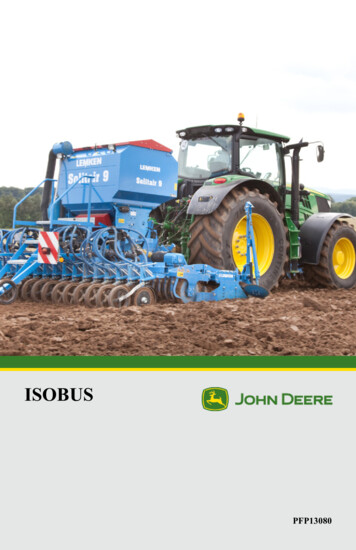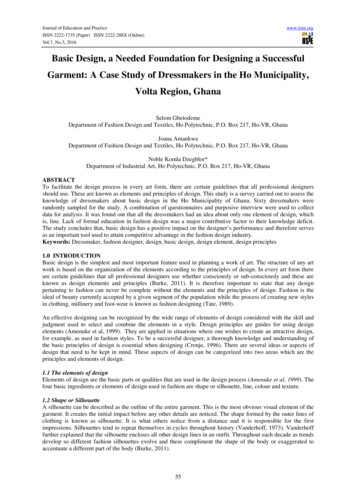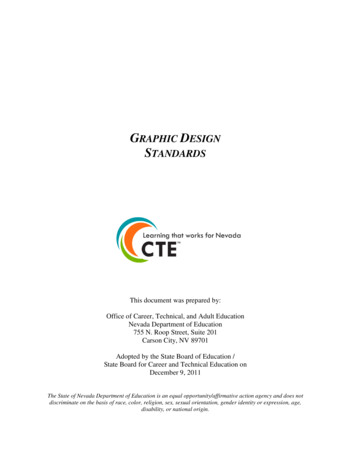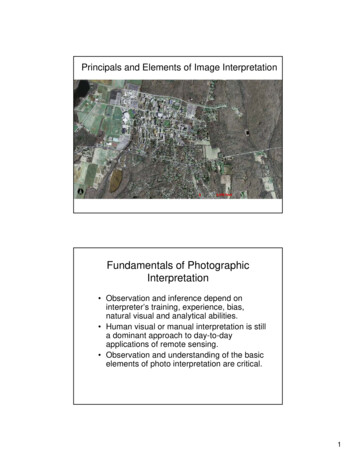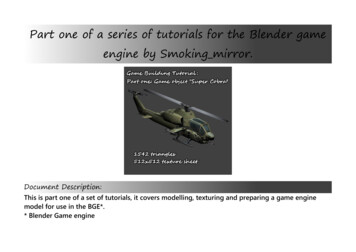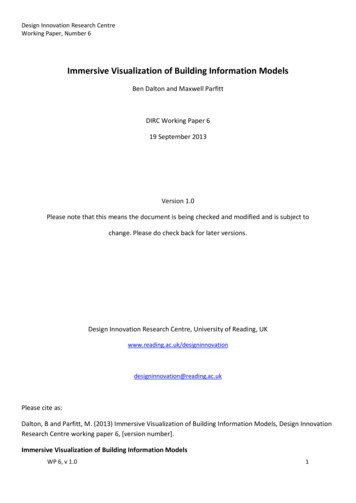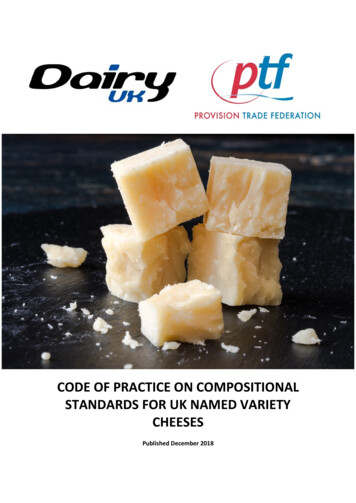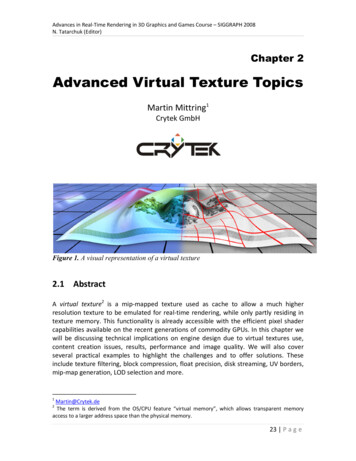
Transcription
Advances in Real Time Rendering in 3D Graphics and Games Course – SIGGRAPH 2008N. Tatarchuk (Editor)Chapter 2Advanced Virtual Texture TopicsMartin Mittring1Crytek GmbHFigure 1. A visual representation of a virtual texture2.1 AbstractA virtual texture2 is a mip mapped texture used as cache to allow a much higherresolution texture to be emulated for real time rendering, while only partly residing intexture memory. This functionality is already accessible with the efficient pixel shadercapabilities available on the recent generations of commodity GPUs. In this chapter wewill be discussing technical implications on engine design due to virtual textures use,content creation issues, results, performance and image quality. We will also coverseveral practical examples to highlight the challenges and to offer solutions. Theseinclude texture filtering, block compression, float precision, disk streaming, UV borders,mip map generation, LOD selection and more.1Martin@Crytek.deThe term is derived from the OS/CPU feature “virtual memory”, which allows transparent memoryaccess to a larger address space than the physical memory.223 P a g e
Chapter 2: Advanced Virtual Texture Topics2.2 MotivationThe diagram in Figure shows how different hardware devices for texture storage can beclassified with a different speed/amount ratio. Caching is a common technique to allowfast access to larger data set to live in slower memory. The virtual texture describedhere uses using traditional texture mapping to cache data coming from the respectiveslower content device.Figure 2. Hardware can be classified depending on a speed/amount ratio.Note: On the GPU a texture lookup operation is limited to one texture only and randomaccess to the whole video memory is not possible, limited in size3 or high latency.Because of that the diagram in Figure lists “Texture” and “Video memory” as separateunits.2.2.1 Texture Streaming is Becoming a NecessityTexture mapping is common place and highly efficient on consumer GPUs for over adecade. Many challenges have been solved by hardware support for mip mapping,advanced texture filtering, border clamp/mirror rules and compressed texture formats.Modern real time rendering engines are faced with another challenge: Screen resolutionand higher quality standards now require high resolution textures and for draw callefficiency it’s even advised to share one texture for multiple objects [NVIDIA04]. Somegraphics hardware already supports texture resolutions up to 8K (8192), but that mightnot be enough for some applications, and, more of a problem, the memoryrequirements grow rapidly with texture size. Because the simulated world size is alsoexpected to be much larger it’s no longer possible to keep all textures in graphic cardmemory (a typical limit is 512MB) and not even in main memory. Having more mainmemory doesn’t help when limited being by the 32 bit address space (2GB on typical32bit OS). A 64 bit OS allows using more main memory but most installed OS and3The maximum size of a texture can be a limiting factor (usually from 1024 to 8192 depending on aspecific hardware generation).24 P a g e
Advances in Real Time Rendering in 3D Graphics and Games Course – SIGGRAPH 2008N. Tatarchuk (Editor)hardware is still 32 bit. Limited amount of physical memory can be compensated byusing virtual memory from hard drive. Unfortunately this option is not viable for realtime rendering as traditional virtual memory (as an OS and hardware feature) stalls untilthe request is resolved. The situation is exacerbated without an available hard drive as itmight be the case on consoles. To overcome this and to get a fast level loading timemodern engines are required to do texture streaming.2.2.2 Problems with Per Mip Map Texture StreamingWe can avoid stalling while requesting to load a specific texture mip level from the harddrive by using a lower mip level as a fallback until the desired level is uploaded to thegraphics card. This is acceptable for real time games and the lower resolution texturecan go unnoticed with sufficient care. Unfortunately it’s basically impossible to add orremove a mip map dynamically. The Direct3D9 function SetLOD() was made for thatbut that only affects the video memory alone and doesn’t change the issue of thephysical and virtual memory. Most hardware keeps all mip maps in one block ofcontinuous memory and updating a single mip level becomes a full mip chain update. InCrysisTM (Error! Reference source not found.) we wanted to save virtual memory so toadjust the mip level we had to create and release textures at runtime. That is very badfor stable performance and MultiGPU (SLI/Crossfire) scaling but it was a manageablesolution at the time. Streaming allowed us to stay within the 32 bit limits with run timedata requirement sometimes exceeding the limits. On 64 bit and enough main memoryor when using half resolution textures the texture streaming is not necessary andperformance is more stable.Figure 3. The screenshot from the game CrysisTM shows the need for texture streaming:large rich environments with many details.25 P a g e
Chapter 2: Advanced Virtual Texture TopicsAvoiding Create() and Release() calls at runtime is possible when textures can bereused, but only if texture formats and sizes match. This is very restricting and evenwasteful on the memory usage, and therefore not a practical option. As a result, thisproblem is a serious issue for game developers and deserves better API and hardwaresupport.The idea of virtual textures is to manage the texture memory at a different granularitythan the mip map level. Often only small areas are required in each mip map and thusuploading a full mip map would be wasteful. It’s much more efficient if we only uploadthe actually required portions. The virtual texture method itself is simple, but it has a lotof interesting related topics attached to it which we will discuss here after explaining thebasic method itself.2.3 Implementing Virtual Textures with Pixel Shaders2.3.1 Virtual Texture – A DefinitionFor the virtual texture we only keep relevant parts of the texture in fast memory andasynchronously request missing parts from a slower memory (while using the content ofa lower mip map as fall back). This implies that we need to keep parts of lower mipmaps in memory and these parts need to be loaded first. To allow efficient texturelookups coherent memory access is achieved by slicing up the mip mapped texture intoreasonably sized pieces. Using a fixed size for all pieces (now called texture tiles) thecache can be managed more easily and all tile operations, e.g. reading or copying, haveconstant time and memory characteristics. Mip maps smaller than the tile size are nothandled by our implementation. This is often acceptable for applications like terrainrendering where the texture is never that far away and little aliasing is acceptable. Ifrequired, this can be solved as well by simply packing multiple mip maps into one tile.For distant objects it’s even possible to fall back to normal mip mapped texturemapping, but that requires a separate system for managing that.As shown in Figure 4, a typical virtual texture is created from some source image formatat preprocessing time without imposing the API and graphics hardware limits on texturesize. The data is stored on any lower access speed device, such as hard drive. Unusedareas of the virtual texture can be dropped (saving memory as a nice side bonus). Thetexture in the video memory (now called tile cache) consists of tiles required to renderthe 3D view. We also need the indirection information in order to efficiently reconstructthe virtual texture layout. Both the tile texture cache and the indirection texture aredynamic and adapt to one or multiple views.To manage our virtual texture we use a quad tree because all required operations canbe implemented in constant time. Here the state of the tree represents the currentlyused texture tiles for a virtual texture. All nodes and leaves are associated with a texture26 P a g e
Advances in Real Time Rendering in 3D Graphics and Games Course – SIGGRAPH 2008N. Tatarchuk (Editor)tile and in a basic implementation only the highest available resolution in the quad treeis used. The lower resolution data is stored as fall back when we drop some leafs andcan also be used to fade in higher resolution texture tiles gradually. We refine orcoarsen the virtual texture only at the leaf level. In addition to the quad tree we needadditional code implementing the cache strategy (e.g. Least Recently Used).Figure 4. Typical usage scenario of the virtual texture method2.3.2 Reconstruction in the Pixel ShaderThe reconstruction needs to be very efficient. While some applications allow efficientindirections per draw call4 or pre split geometry5, this is too limiting in general and hardto implement efficiently for general geometry. Simply using a pixel shader to implementthis functionality is straight forward and intuitive. This code returns the texture4Games like Far CryTM or CrysisTM render one terrain sector with texture tile per draw call. That allows thetile cache to be split in individual texture and that simplifies tile updates.5It’s possible to setup the vertex texture coordinates to render multiple tiles in one draw call.27 P a g e
Chapter 2: Advanced Virtual Texture Topicscoordinates in the tile cache texture for a given virtual texture coordinate. This evenallows emulating texture coordinate addressing modes like “warp” or “mirror”.Here we assume at least 32 bit float precision in the computations (which is notsupported by older pixel shader versions, but is common by latest generations ofDirectX 9.0c capable graphics hardware). Note that on DirectX 9 you have to offsetyour texture lookups by half a texel. In OpenGL you have to do similar computations.Efficiency is very important as this code is executed for every pixel. This is why thequad tree traversal in the pixel shader is replaced by a single unfiltered texture lookup.This texture (now called indirection texture) can be quite small in memory and becauseof the coherent texture lookups it is also very bandwidth friendly. A single texturelookup allows computing the texture coordinates in the tile cache with simple math inconstant time.The idea of implementing a virtual texture using a pixel shader received a lot ofattention after John Carmack mentioned the “Mega texture” technique he has beenworking on (as described in [IDTECH507]). The technique is used in the commercialproduct “Quake Wars” and is currently developed to a more generalized solution at idSoftware. The basic idea is clear, but implementation details are not described. SeanBarrett investigated further and shared his knowledge and his version of the method atGDC 2008. It’s an advised read for anyone that wants to implement it [BARRETT08].28 P a g e
Advances in Real Time Rendering in 3D Graphics and Games Course – SIGGRAPH 2008N. Tatarchuk (Editor)The following HLSL code can be used in the pixel shader to compute for the given virtualtexture coordinate the associated tile cache texture coordinate:float4 g vIndir;float4 g Cache;float4 g CacheMulTilesize;// w,h,1/w,1/h indirection texture extend// w,h,1/w,1/h tile cache texture extend// w,h,1/w,1/h tile cache texture extend//* tilesizesampler IndirMap sampler state{Texture IndirTexture ;MipFilter POINT;MinFilter POINT;MagFilter POINT;// MIPMAPLODBIAS 7;// using mip-mapped indirection texture,// 7 for 128x128};float2 AdjustTexCoordforAT( float2 vTexIn ){float fHalf 0.5f;// half texel for DX9, 0 for DX10float2float2float2float4TileIntFrac vTexIn*g vIndir.xy;TileFrac frac(TileIntFrac)*g vIndir.zw;TileInt vTexIn - TileFrac;vTiledTextureData tex2D(IndirMap,TileInt fHalf*g vIndir.zw);float2 vScale vTiledTextureData.bb;float2 vOffset vTiledTextureData.rg;float2 vWithinTile frac( TileIntFrac * vScale );return vOffset vWithinTile*g CacheMulTilesize.zw fHalf*g Cache.zw;}Listing 1. HLSL Shader Code to compute the texture coordinates in the tile cache textureThe code can be optimized further but care must be taken to keep the floating pointerror minimal. The texture cache should not have mip maps and the lookup should bebilinear only.In [BARRETT08] Sean Barrett mentions the simplest shader fragment he came up with(with a hint from John Carmack):tex page, vtc , tex0, 2Dmad phys.xy, vtc , page.xyxy, page.zwzwtex color , phys, tex1, 2DListing 2. Pixel shader assembler code to compute the texture coordinates with the tile cache lookupThis would be 2 instructions only for the texture coordinate computation. We haven’ttried that but float precision might be an issue, especially when using 64 bit or even 32bit textures using a 128 bit texture may be slower on some hardware.29 P a g e
Chapter 2: Advanced Virtual Texture Topics2.3.2.1 The Indirection TextureThe indirection texture can be easily generated from the data in the quad tree. With asingle unfiltered lookup into the indirection texture and simple math with constants wecan compute the texture coordinates in the tile cache. The values stored in a texelcontain the scale of the tile and the 2D offset in tile cache. In our implementation weuse a 64 bit texture with FP16 channels. Using a 32 bit texture format with 8 bitchannels is possible but you have to adjust the values in the pixel shader with additionalinstructions. Beware that scaling might not return the values you would expect. Bystoring a value from 0 to 255 in the texture you get values from 0.0 to 1.0 in the pixelshader. This result is a guaranteed. Scaling these values by 255.0 you would think wouldresult in integer values. However, this may not be the case. Floating point math can bean issue, but even worse is that on some hardware the precision seems to be lower,rather comparable to 16 bit floats. In [BARRETT08] the problem was solved by rounding6,but the author admits that this might be not the most efficient approach.Here we use a 64 bit (4 channels FP16) texture format as it is compact and doesn’tsuffer from the issues mentioned before. The memory bandwidth requirements for ouruse are minimal as the method has a very high texture lookup coherency, i.e. texturecache misses are rare. However depending on the hardware the lookup itself mightrequire multiple cycles on 64 bit or 128 bit texture formats. Integer textures, an integertexture lookup7 and integer math can be a good choice on some hardware as we wantconstant precision over whole domain and float is likely to cause problems here. Thiswould also allow using higher resolution texture caches ( 8K) easily.67To get the integer value from of a 8 bit channel this shader code was used: floor(channel*255 0.5)Direct3D 10 offers the HLSL Load() but only unfiltered30 P a g e
Advances in Real Time Rendering in 3D Graphics and Games Course – SIGGRAPH 2008N. Tatarchuk (Editor)The following C/C code can be used to compute the indirection texture content:// float to fp16(s1e5m10) conversion (does not handle all cases)WORD float2fp16( float x ){uint32 dwFloat *((uint32 *)&x);uint32 dwMantissa dwFloat & 0x7fffff;int iExp (int)((dwFloat 23) & 0xff) - (int)0x7f;uint32 dwSign dwFloat 31;return (WORD)( (dwSign 15) (((uint32)(iExp 0xf)) 10) (dwMantissa 13) );}WORD texel[4];RECT recTile;int iLod;int iSquareExtend;float fInvTileCache;//////////texel outputin texels in the tilecache texture0 full domain, 1 2x2, 2 4x4, .indirection texture size in texelstile.Width / texCacheTexture.Widthtexel[0] float2fp16(recTile.left*fInvTileCache);texel[1] float2fp16(recTile.top*fInvTileCache);texel[2] float2fp16((1 iLod)/ iSquareExtend);texel[3] 0;// unusedListing 3. C/C code to compute the content of the FP16 indirection textureUsing a mip mapped indirection texture requires a few more texture update operationsbut it also allows per pixel LOD which looks much smoother. The per pixel LOD codecomputes a lower (or the same) LOD that is available in the texture tile cache. Standardtexture mapping with LOD adjustment8 can be sufficient but anisotropic texturemapping would provide better quality at steep angles. In Figure different texturefiltering modes are shown.The virtual texture technique can be extended to more than two dimensions. By usingvolume textures or multiple slices in a 2D texture the lookup is still quite efficient.However multidimensional content scales quickly regarding memory demand and thenit’s better to adapt at a finer granularity, i.e. a smaller tile size is needed. In GPGPUapplications (such as [LEFOHN03]) data is often processed in volume textures and oftenbarely fits into video memory. Caching can be done as usual but processing mightrequire the full data set and locally varying LOD is not common and thus dynamicmethods are often not used there.8See MIPMAPLODBIAS in the pixel shader code31 P a g e
Chapter 2: Advanced Virtual Texture Topics2.3.2.2 Efficient Filtering Through BordersA naive implementation of bilinear filtering requires 4 lookups into the indirectiontexture, 4 lookups in the tile cache, followed by bilinear interpolation in the shader.While this may be somewhat reasonable for a hardware implementation, in the pixelshader implementation this is wasteful with respect to performance. Adding a smallborder is much more efficient as the much more efficient built in hardware bilinearfiltering can be used. A one pixel border is enough to get bilinear filtering onuncompressed textures but in order to add support for DXT compressed textures a 4pixel border is necessary. This is because the DXT block compression is based on 4x4blocks and to avoid seams you need to add a full block to the border. Furthermore it’sbetter to center the tile to get more stable results for imprecise texture coordinatecomputations. That also simplifies the implementation of more advanced filtering likebi cubic filtering or anisotropic filtering. The later one would be an interesting topic forthis chapter but because we haven’t done any implementation we skip it here.Unfortunately the additional borders waste memory, destroy the power of two textureextents, and break the memory alignment of the tiles. If you have non power of twotiles it’s probably better to add some padding to the tile cache to create the texture withpower of–two dimensions9. Otherwise you might be faced with undefined memory andperformance characteristics from the APIs and graphic card drivers.Alternatively, instead of adding the border to the tile we can also reduce the tile size bythe border to allow the sum of both to be power of two10. This is best for the hardwareimplementation but resulting visual quality can suffer a lot. That loss is due to aliasing inthe mip maps caused by the down sampling of the source texture to slightly less than itshalf size. A good down sampling algorithm can limit the aliasing in the lower mip mapsbut even the top mip map is affected by this design decision and that can be visibleespecially when using regular patterns in the texture.2.3.2.3 Maximum Size of the Virtual TextureAs mentioned, our implementation is based on a single indirection only and assumes alltiles in the tile cache have the same size you can compute the virtual texture resolution:Resolutionvirtual texture ResolutionIndirection texture * Resolutiontexture tile without borderExamples: 16k 65k 256k 9128 * 128256 * 256256 * 1024e.g. for 7 tiles with 128 4 pixel extend (128 4)*7 924, the next power of two extend would be 1024e.g. for 8 tiles with 124 4 pixel extend (124 4)*8 1024, but the usable tile size is no longer power oftwo1032 P a g e
Advances in Real Time Rendering in 3D Graphics and Games Course – SIGGRAPH 2008N. Tatarchuk (Editor)Using a larger tile size limits the adaptive property of the method and using a largerindirection texture becomes inefficient when updating the texture, especially with CPUupdates. Unfortunately there is another limit for virtual texture resolution. With atypical implementation using floating point math to run on older hardware the precisionof the float computations becomes a problem when the virtual texture resolutionbecomes close to 65K. We may see reasonable performance for colour look ups;however, bilinear filtering will no longer be efficient. We can alleviate the problem bycareful ordering of our floating point operations, however, integer maths avoid this alltogether.2.3.2.4 Storing Different Attributes in the Tile CachesYou can comprise one tile cache of multiple textures to store attributes like diffuse,specular or normal maps as long they share the same tile positions. After computing theposition in the tile cache it can be efficiently used for multiple lookups. With a biggerborder you can even use differently sized textures for the attributes you want to store.2.3.2.5 Splitting the Tile Cache Over Multiple TexturesInstead of storing different attributes you can use multiple tile caches to get more cacheunits, but here a new problem appears. Normal hardware rendering only allows totexture from the same textures in one draw call. Performance can be much worse whentrying to overcome this limitation: Texture lookups through texture arrays are a bitslower (Direct3D 10 only) and the alternative of fetching data from several texturesand masking the result is even slower. That’s why it’s good to keep all tiles required forone draw call in the in the same tile cache.When using multiple tile caches you might end up with one tile cache overused whileanother one is underused. Moving objects between different caches might be an optionbut performance will no longer be constant, no matter what strategy you pick. Groupingspecific types of objects (e.g. one tile cache for terrain and one for objects) is thesimpler solution.The maximum texture resolution supported on some hardware limits your tile cachesize. Here we have two simple solutions: You can tweak the LOD computation andaccept blurrier results or you add another cache in the graphic card memory, betweenthe texture and the main memory. Copying between VRAM and the texture is expectedto be fast. By computing the local LOD required as small as possible the tile cache can bekept small (see the LOD computation methods described later). Rendering a view ispossible from the main tile cache, changing view angle additionally requires thesecondary cache and moving the view position requires secondary cache updates. The33 P a g e
Chapter 2: Advanced Virtual Texture Topicslater ones can come from a slow media like the DVD and to minimize latency morecache stages can be done on the hard drive and even in main memory.2.3.2.6 Tile Cache Texture UpdatesAs already mentioned, to avoid bilinear filtering artefacts with DXT block compressedtextures we require an additional border of 4 pixels. Due to the lossy DXT compressionwe need exactly the same block content when compressing blocks of neighbour tiles;otherwise we might reconstruct wrong colour values and thus resulting in visible seams.There are three basic methods to update a part of a mip map from CPU. Depending onthe specific graphics API11 and on the graphics card use and the driver version,performance characteristics may be not clearly defined. This is actually is the majorproblem of the implementation and on some configurations it might even make themethod unusable. Further testing is needed to quantify this claim. Experience showsthat such driver issues often get addressed after a major game shipped using thetechnology.For the update of the tile cache texture we have some requirements:Fast in latency and throughputBandwidth efficient (copy only the required part)Small memory overheadUpdates should happen without stalls but correctly synchronized to get the righttexture stateWhen updating the content by CPU there should be no copy from GPU memoryto CPU memory (discard should be used)For fast texturing from the tile cache texture it should be in the appropriatememory layout (swizzled12) and memory type (video memory). Note that onsome hardware compressed textures are stored in linear form (not swizzled).Multiple tile updates should have linear or better performanceAll methods require some locking of either a full texture or a part of the texture. Thedriver might do a full update and you probably would only notice on less powerfulhardware or with heavy bus usage. We’re still investigating further into this area. Todescribe the three basic methods we use the Direct3D 9 API.Method 1: Direct CPU update:The destination texture needs to be in D3DPOOL MANGED and via the LockRect() functiona section of the texture is updated. This method wastes main memory, and most likelythe transfer is deferred till a draw call is using the texture. This method is simple butlikely to be less optimal when compared with the next two methods.1112OpenGL, Direct3D 9, Direct3D 10 or the APIs used on modern consolesA swizzled memory layout is a cache friendly layout for position coherent texture lookups.34 P a g e
Advances in Real Time Rendering in 3D Graphics and Games Course – SIGGRAPH 2008N. Tatarchuk (Editor)Method 2: With (small) intermediate tile texture:Here we need one lockable intermediate texture hat can hold one tile (includingborder). With the LockRect() function this texture is updated as a whole. With theStretchRect() function the texture is then copied into the destination texture to replaceone tile only. This does not work with compressed textures (DXT) as they cannot beused as render target format. For the StretchRect() function the source and thedestination requires to be in D3DPOOL DEFAULT and that requires the source to beD3DUSAGE DYNAMIC to be lockable. To find out if the driver supports dynamic textures,you are ought to check the caps bits for D3DCAPS2 DYNAMICTEXTURES but according to thelist in the DirectX SDK even the lowest SM20 cards support this feature.Method 3: With (large) intermediate tile cache texture:This method requires a lockable intermediate texture in D3DPOOL SYSTEM with the fulltexture cache extend. With LockRect() the intermediate texture is updated only whererequired and a following UpdateTexture() function call is transferring the data to thedestination texture. UpdateTexture() requires the destination to be in D3DPOOL DEFAULT.2.3.2.7 Indirection Texture UpdateOnce the new tile is in the texture cache the indirection texture can be updated. Wewish to make this an efficient operation. The indirection texture requires little memorytherefore bandwidth is not a issue. However, using several indirection textures andupdating them often can become a performance bottleneck. The texture can beupdated from the CPU by locking or uploading a new texture. This can cause irregularperformance characteristics on current APIs but at the same time has proven to be anacceptable solution. Locking a resource that is in use by the GPU can definitely producesome hitches unless clever renaming is done on the driver side.If you choose to have a render target texture format for your indirection texture you canalso consider GPU updates triggered by CPU. Updates can be done by draw calls andsimple quads can be rendered to the texture to update even large regions efficiently.There shouldn’t be too many updates as tile cache updates should be rare and both relyon each other.In our implementation the indirection texture still has a channel left and storing a tileblend value is possible. With extra shader cost this allows hiding texture tilereplacement by slowly blending tiles in or out. A filtered blend value would be evennicer as it allows hiding the seams between the tiles. However this can hide details andexperience showed satisfying results without this feature.35 P a g e
Chapter 2: Advanced Virtual Texture Topics2.3.3 Mip Mapping and Virtual TexturesIt’s best to generate the mip maps and do the texture compression in an offline process.This way a high quality implementation can be used and the data is optimally preparedfor fast access. This is similar to a normal production pipeline but some details differ.For efficient streaming the mip maps are organized on disk as tiles of continues blocksand in that form the data needs to be generated. Most mip map computationimplementations assume that the textures can be fully loaded into memory. In thatcase, developers may waste memory on a large texel format and buffer duplication.When using huge virtual textures you have to assume that the texture cannot beprocessed in memory, especially if you want your tools to run on 32 bit OS. Fortunatelyit’s not too difficult to make the mip map generation code running without keeping thefull data in memory.2.3.3.1 Out of Core Mip Map GenerationTypically the input data is stored on the disk in a standard image format. For efficientprocessing we convert it into a form that allows fast access for algorithms with read andwrite operations with strong locality. Here again we can make use of some tile baseddata layout. The tile size here is not dependent on the virtual texture tile size and theborder pixels are undesired because that would add redundancy. Redundant data likethis can speed up the processing under certain circumstances, but it might cause otherproblems in the system.We need a class that can read a section of the image but completely hiding the tilebased data layout. The input area can be defined by any rectangle, even outside of thesource domain. Pixels outside of the domain can return the wrapped content or aborder colour. The class caches tiles that have been requested recently and it alsoshould supports writing tiles temporary on the hard drive. This is used to store the mipmap levels during processing. Using the same functions to access the source data andthe intermediate data simplifies the code a lot.Generating mip maps is simple: Generate the lowest mip map of the image recursivelyby requesting i
A visual representation of a virtual texture 2.1 Abstract A virtual texture2 is a mip rmapped texture used as cache to allow a much higher resolution texture to be emulated for real rtime rendering, while only partly residing in texture memory. This functionality is already accessible with the efficient pixel shader


